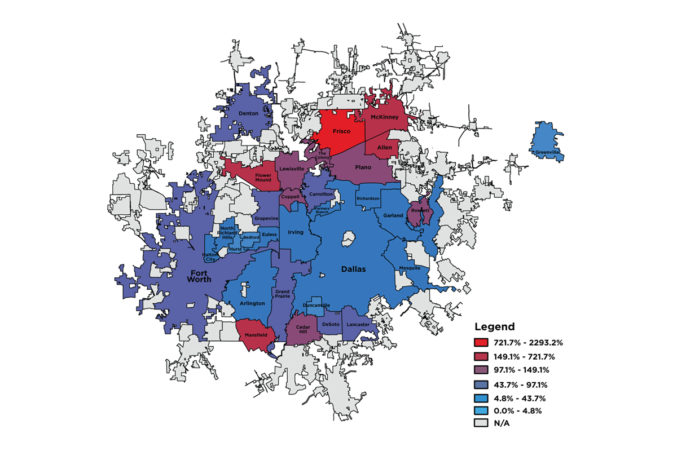As bragging rights go, ours are pretty sweet: The Dallas-Fort Worth area added more jobs than any other U.S. metropolitan area over the past quarter century.
From the start of 1990 to the end of 2016, the DFW metropolitan statistical area increased total employment by 1,465,581 jobs, topping much bigger New York by more than 70,232 jobs and surpassing fellow Sunbelt boomtowns Houston (by 195,012 jobs) and Atlanta (by 232,351 jobs).
A closer look at the geographical distribution of DFW employment gains tempers the “We’re No. 1” back-slapping, however—at least for Dallas itself. Just 122,699 of the quarter century’s MSA net job gains were within the city limits—less than 9 percent.
The Austin, Houston, and San Antonio MSAs haven’t kept pace with DFW in net job creation since 1990. However, their core cities all added more than twice as many jobs as Dallas (see chart). Even Fort Worth did significantly better than Dallas, increasing employment by 173,839 jobs.

By an overwhelming margin, DFW’s net jobs gains have come in the suburbs. Recent headlines about large corporate relocations and consolidations, led by the highly publicized moves of Toyota, Liberty Mutual, and State Farm, are just the latest wave of a long trend of employers choosing to locate outside Dallas’ city limits, particularly in Collin and Tarrant counties.
Even casual observers should be aware of the suburbanization of local jobs, but our data show the sheer size of the gap between the core cities of Dallas and Fort Worth and their suburbs. All told, DFW-area suburbs added 1,169,043 jobs since 1990, or nearly 80 percent of the MSA’s net employment gains. In other words, the Dallas area’s reputation for job creation stems largely from the suburbs.
The data point to a swath of torrid job creation across the northern suburbs—from Flower Mound on the west to McKinney and Allen to the east. Frisco, a largely rural outpost with just 3,374 jobs in 1990, added 77,374 jobs in the ensuing quarter century, putting it atop DFW with a phenomenal growth rate of nearly 2,300 percent.
McKinney comes next at 720 percent, followed by Allen and Flower Mound. Rowlett, Coppell, Lewisville, and The Colony also performed well. Plano actually added more jobs than any other DFW suburb since 1990, but began the period with a larger employment base, diluting its percentage gain.
Not all action is taking place in the suburbs to the north. Mansfield and Cedar Hill, two cities on the MSA’s southern tier, had strong job growth in the past quarter century as well.

In terms of lagging job growth, Dallas and Fort Worth aren’t unusual. A half-dozen MSAs have seen employment decline in their core cities—among them, Detroit, Cleveland, Baltimore, and New Orleans. What’s more, Dallas fared better than the core cities in many other MSAs, including Atlanta, Chicago, Miami, Philadelphia, Orlando, and Washington.
Overall, Dallas ranks a lackluster 24th among the core cities of 37 large U.S. urban areas in share of the MSA’s employment gains since 1990. Add in Fort Worth as a central city, and North Texas’ ranking improves to 18th—not much to brag about.
The national picture makes it clear that nearly all central cities face hurdles in attracting and holding onto jobs. Suburbs often offer an edge in cost, a key to any business. It starts with cheaper real estate. Taxes are likely to be lower, too. Suburban governments may be business-friendly, eager to bend over backwards to accommodate new employers by cutting red tape and offering financial incentives. Infrastructure, including airports and roads, may make it easier to do business in the suburbs, especially for such transport-dependent industries as warehousing.
Some companies might give weight to where their workers prefer to live. Suburbs offer affordable housing and usually maintain better schools than inner cities. Crime rates are low. Frisco, Plano, and other suburbs now offer the kind of amenities once only found in big cities—sports, dining, entertainment, and recreation.
In addition to poor schools and crime, core cities are hampered by aging infrastructure and sclerotic bureaucracies. Some cities, like Dallas, are hemmed in by existing suburbs, preventing them from capturing at least some of the suburban job growth by annexing unincorporated land.
America’s core cities can’t afford to be indifferent to the suburbanization of job growth. Increasing employment means a growing population, more investment in housing and new business facilities, rising retail sales, and greater tax revenue. Suburbs and central cities are competing for these benefits. The data clearly says the suburbs are winning—both across the nation and in Texas.
Dallas has made significant strides in recent years in revitalizing downtown and its environs—the building boom is plain to see. It’s encouraging to note that job growth has picked up a bit in recent years as law firms and other businesses locate downtown. Since 2011, Dallas has matched the suburban job-growth rate, ending two decades of being a drag on overall MSA employment.
The goal will be to continue on that path. Making it easier and more affordable to do business in Dallas will help, of course. The city also needs to address urban ills, perceived or real, that push families toward the suburbs.






